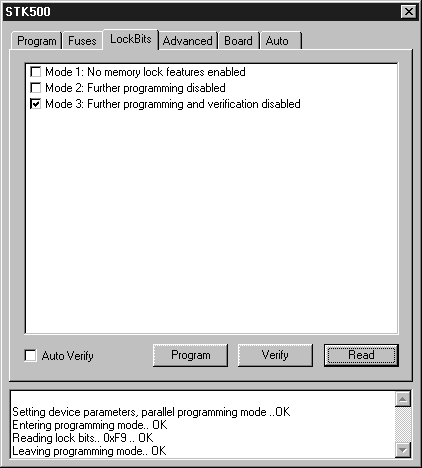
Similar to the "Fuses" settings, the "Lock Bits" tab shows which lock modes are applicable to the selected device. A lock mode may consist of a combination of setting multiple lock bits. This is handled by STK500 User Interface, and the correct lock bits are programmed automatically for the selected Lock mode. Once a "Lock mode" protection level is enabled it is not possible to lower the protection level by selecting a "lower" degree of protection by setting a different "Lock mode". The only way of removing a programmed lock bit is to do a complete chip-erase, erasing both Program and Data memories. One exception exists though: If the target device have a programmed "EESAVE" fuse, the contents of the EEPROM will be saved even though a complete chip erase on the device is performed.

For devices that support ISP programming, all lock bits are accessible in both ISP and High-Voltage programming mode. Note that some parts do not support either ISP programming mode or High-Voltage programming. The appearance of the check box describes whether the lock bit is readable and/or writable in the active programming mode.
 The lock bit is readable and writable in the active prorgamming mode.
The lock bit is readable and writable in the active prorgamming mode.
 The lock bit is readable but not writable in the active prorgamming mode.
The lock bit is readable but not writable in the active prorgamming mode.
 The lock bit is not readable but writable in the active prorgamming mode.
The lock bit is not readable but writable in the active prorgamming mode.
 The lock bit is neither readable nor writable in the active prorgamming mode.
The lock bit is neither readable nor writable in the active prorgamming mode.
If a lock bit is not readable in the active programming mode, the value displayed in the window cannot be trusted.
See Also